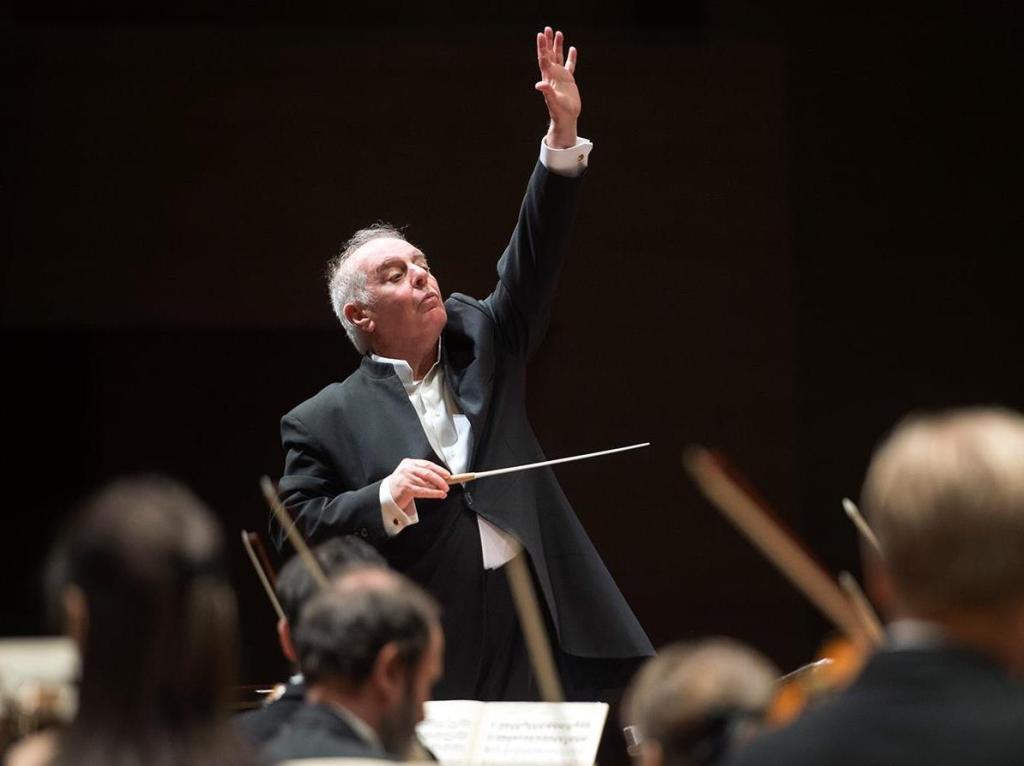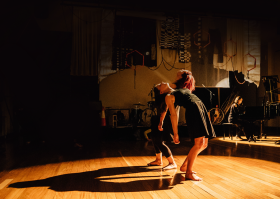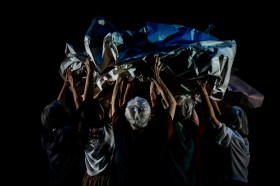Daniel Barenboim conducts Staatskapelle Berlin. Photo via Sydney Opera House.
Coinciding with the welcome release of Brahms’ Symphonies on the Deutsche Grammophon label this month, this tour presented three concerts by one of Germany’s most revered orchestras under the direction of its esteemed musical director Daniel Barenboim, one of the world’s finest musicians. The three-day program comprised all of Brahms’ four Symphonies as well as Schubert’s eighth unfinished symphony and Beethoven’s third, the ‘Eroica’. Touring a 98-member orchestra, seven staff and a world-famous conductor is no small feat and the Sydney Opera House, supported by its donor group ‘The Greats’ is commended for the vision of this major undertaking to celebrate the 45th anniversary of the Sydney Opera House. An attractive printed program with specially commissioned artwork by Miri Badger made a fitting souvenir.
It was a fascinating experience to hear all four of Brahms’ symphonies in chronological order showing their relation to Bach and Beethoven and displaying the vivid connections between each of Brahms’ works, especially the first and fourth. Seen as the natural successor to Beethoven and, though he was not to know it, one of the last custodians of the great Austro-Germanic symphonic tradition, Brahms struggled with his first Symphony in C minor for many years.
Excellence in voicing, tuning and phrasing were immediately apparent in this orchestra under Barenboim. But over three nights of hearing this extraordinary music-making, Barenboim demonstrated fastidious attention to the smallest detail.
A choral director in Hamburg and Vienna, Brahms thinks chorally when writing for the orchestra, providing a balance between bass and soprano with a blend of the voices within. This is precisely why Barenboim placed the eight double bases at the back of the stage facing the audience. Often he was seen weighing the outer voices moving in contrary motion with wide expansive gesture.
The opening work was changed from the second symphony as programmed to the mighty first in C minor, completed only when the composer was in his early 40s. It successfully takes on the heritage of Beethoven’s 9th, but with its long and dramatic pedal in C minor it could also be seen as paying homage to the dramatic opening of Bach’s St Matthew Passion. From the start the ensemble provided a gloriously unified sound, with perfectly balanced ‘voicing’ between sections.
Barenboim’s gestures are for the most part kept to an absolute minimum. In fact so well was this music known by the ensemble and so close its rapport with its music director that often he simply held out a steady hand and glanced at sections of the orchestra, conveying a kind of mysterious yet intense communication. The hushed tones of the Andante sostenuto conveyed phrases that floated like gossamer, with noteworthy solos from oboist Gregor Witt and concertmaster Wolfram Brandl. The Un poco Allegretto e grazioso was as fresh as morning dew with its garlands of woodwind figuration and closely worked rhetoric. Finally the Adagio: Più Andante – Allegro ma non troppo, ma con brio – Più Allegro crowned the symphony with its sunset Alpine horn melody and deep voiced strings. Here was wonderful breadth and richness with a regal closure in C.
Effortless rapport continued in the Symphony No 2 in D major. The Allegro ma non troppo was danced graciously, with violins caressing their cushioned phrases, while the Adagio non troppo – L’istesso tempo, ma grazioso soared like a kite in the wind. The following Allegretto grazioso (Quasi Andantino) – Presto ma non assai – Tempo I was charming and delicate while Maestro Barenboim cast his spell over the final Allegro con spirito. The audience’s reaction to the opening performance was memorable: a standing ovation with loud cheering.
On Monday night the program comprised Brahms’ Symphony No 3 in F major, Op 90 and his final work in the genre, Symphony No 4 in E minor, Op 98. The third opened with its thunderous thud in the Allegro con brio – Un poco sostenuto – Tempo I, with a brass section from heaven bringing the movement to its glorious fruition. The inner Andante and Poco Allegretto movements enchanted for their dream-like romanticism and tender buoyancy while the highly dramatic final Allegro never flagged.
The ensemble carried the opening Allegro non troppo of the final symphony and its lilting and elastic theme with delicacy and grace. The Andante moderato reached a perfect pace from the outset while the Allegro giocoso – Poco meno presto – Tempo I was all ebullience, complete with some virtuoso triangle playing. Bach echoes once again in the Allegro energico e passionate – Più Allegro with its Baroque passacaglia form. Overall the second night was very nearly as good as the first, with some slightly uneven phrases and a few issues with brass voicing that may have come from the fatigue of jetlag.
The final night’s offerings delighted for the rapport established from the opening hushed bars of the Schubert Symphony in B minor, D759 ‘Unfinished’ with phrases melded one into another. Here a reduced orchestra with double basses now placed to the left created a different but no less detailed and magical sound. The Andante con moto explored the very limits of sheerness of sound such that the textures were connected by a mere thread.
Beethoven’s Symphony No 3 in E flat, Op 55 ‘Eroica’ received a life-affirming performance, with plenty of joyful thump and bluster for good measure in the opening Allegro co brio. The Marcia funebre (Adagio assai) was too slow and romantic for my taste, sounding almost Mahlerian and histrionic. The Scherzo (Allegro vivace) – Trio – Scherzo with its tricky off-beats led to a comparison with the Brahms Symphonies and the horn Trio section was a joy to behold the ear. The Finale (Allegro molto – Presto) was flawless and the Coda provided an outpouring of emotion as the orchestra bade farewell to a most grateful audience.
5 stars ★★★★★
Staatskapelle Berlin
Daniel Barenboim, conductor
25-27 November, 2018
Concert Hall, Sydney Opera House





